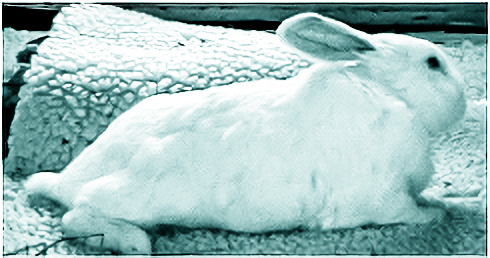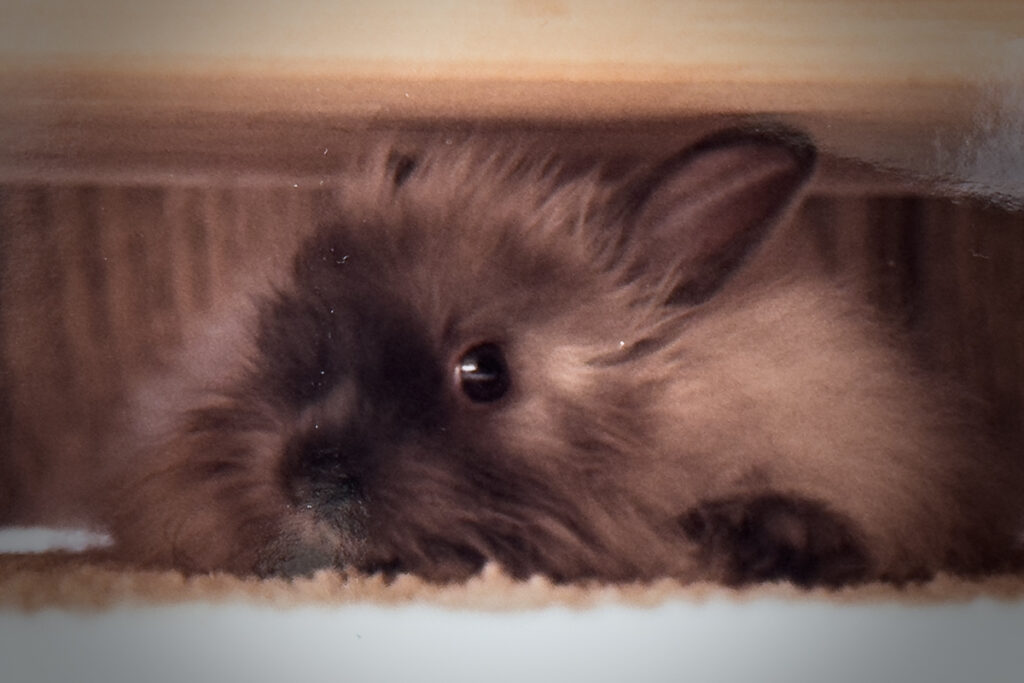Marinell Harriman in consultation with Carolynn Harvey, DVM and Cynthia Besch-Williford, DVM, PhD
When we first began to encounter rabbits with diminished control of the hindquarters, the assumption was that back injury, most likely from improper handling, was the cause. Although a rabbit’s skeletal structure makes it very possible to suffer a broken back, this has not been the leading cause of paralysis in our foster homes. Since our fosterers have collectively rescued and lived with well over two-thousand rabbits, and our members across the country report their rabbits’ health problems to us, we can report back to our readers from this growing database.
How Does a Rabbit Become Disabled?
Neurological impairment–in the form of partial or complete paralysis, loss of coordination, seizures, and head tilt– has diverse causes. Besides trauma to the head or back, causes may include strokes; tumors; bacterial infections–of the inner ear, brain, spine, lungs, bones, or joints; protozoan infections; viruses; nematodes; toxins; degenerative disease; and even osteoporosis.
Probably the most common but least recognized cause of rabbit paralysis is protozoal infection. A disease that has taken its toll on many rabbits across the U.S. is Encephalitozoonosis. The organism that causes it is a protozoan parasite called Encephalitozoon cuniculi, or in short E. cuniculi.
The Long Search
In 1989 I knew of 25 paraplegic rabbits. One of them was my own beloved Phoebe. When autopsies on several rabbits failed to show identifiable causes we started calling it the “mystery disease” or “old-bunny paralysis.”
Dr. Carolynn Harvey began to follow all possible leads. During the next two years, we recorded every case of paralysis reported by our members across the county and noted in particular the cases in which bacterial infection had been ruled out. We tested blood and urine from our own rabbits and ran diagnostic tests for toxoplasmosis, corona viruses, lead poisoning, and many others.
Rediscovering an Old Disease
We asked for help from neuro-pathologists. When paralyzed rabbits died, Dr. Harvey sent brain tissue to Dr. Richard Evans in Southern California. He donated time and materials and electron microscopy.
By January 1991 the only positive identification that had ever turned up was Encephalitozoon cuniculi. Dr. Evans identified the organism early, but we did not realize the full significance until much later.
Most veterinary manuals and research labs say that these parasites do not usually present a problem in live animals and are found only incidentally at necropsy in animals who have died from other causes. Upon perusal, however, we noted an important difference between our house rabbits and rabbits being used in laboratory research. Our rabbits are much older. Most HRS members, with the aid of improved veterinary medicine, have kept their rabbits alive into their senior years. Most rabbits in laboratory settings are under two years old. Perhaps E. cuniculi would indeed cause problems if all rabbits were routinely kept until an older age.
Since we suspected a particular agent to be responsible for the rabbit disease, we decided to monitor the health of a large number of rabbits over a long period of time and see if there was a correlation. We needed a way to identify the rabbits who had the parasites, so that we could keep records and watch them.
The Right Test
Dr. Drury Reavill of the Sacramento area spent a day making phone calls and tracking down the right test for us. Knowing our philosophy as an animal-welfare organization, she found a reliable non-destructive test conducted by the University of Missouri. For our study, veterinarians came to our fosters homes and drew a small amount of blood from each rabbit. They also collected blood from rabbits belonging to people who wished to participate in the study. Each time a batch of 50-70 samples accumulated, the serum was shipped air-freight to the lab. The lab then checked the serum for antibodies to E. cuniculi. If antibodies are present, it indicates that the animal has been exposed to the parasite and an immune response has been initiated. The greater the infection, and the more recent, the greater the antibody quantity, or titer, will be detected. This procedure is analogous to what is done in an AIDS test.
Because E. cuniculi are protozoa, they do not respond to antibiotics in the same way as bacteria. At the present time there is no drug therapy in the United States that can destroy E. cuniculi. That is the job of the immune system. However, some animals appear to be improved or stabilized when treated with Tetracycline or Chloramphenicol.
Inside the body, immune defenses are required to rid the animal of the parasites. If the animal is compromised by other kinds of infections or by stress, then the defense system won’t be adequate to fight the E. cuniculi. (e.g. “My rabbit came down with enteritis and became paralyzed.” or “My rabbit got snuffles and lost the use of his hind legs.”)
The Route Traveled
The parasites are ingested. From the gastrointestinal tract they move in the bloodstream to the kidneys and other organs. The parasites can replicate in the kidneys and be shed in the urine. It’s only while the E. cuniculi are in the kidneys (often causing pitting and scarring) that the infected animal is contagious. Encephalitozoons can be seen in brain cells long after kidney infection has resolved (possibly because it may take longer to break through the protective barrier provided by brain blood vessels). The parasites may simply remain there without causing any more damage. However, if they try to replicate, the damage can be severe.
Neurological damage does occur at some frequency, and we’re not sure whether the damage is incurred by E. cuniculi directly, through natural growth and replication, or by the immune response itself. There are many well documented diseases in animals and humans, where the immune system reacts to a reasonably non-threatening pathogen, and the immune response itself is responsible for the disease state. If this is the case with E. cuniculi, it would mean the immune destruction of neural tissue could be a chronic problem and persist long after the parasite itself has been eliminated. So, in some paralysis cases, we may be seeing only the end result a of a process which was catalyzed months or years before.
Something to note here, if you have an infected rabbit who lives with other rabbits, is that most certainly by the time you see the outward signs of clinical disease, it is well past any contagious stage. The parasites are no longer in the kidneys. However, the spores that have been shed in the urine can remain in the environment for another month. Other rabbits can pick up spores from the environment for several weeks after the infected rabbit has stopped shedding. And since many other animal species can carry and shed these parasites, a rabbit who runs on the ground outdoors is more likely to pick them up.
Encephalitozoon Cuniculi Facts Review
- E. cuniculi are shed only in the urine.
- Infectious period lasts only a few days to a few weeks.
- The infected animal is not contagious after the E. cuniculi leave the kidneys.
- E. cuniculi are carried in the blood to other parts of the body, particularly neural tissue.
- Spores from infected urine can remain in the environment for a month.
- The parasites can infect and be shed by many other animals but seldom cause clinical disease in other animals.
- A high number of rabbits throughout the United States have been infected at some time during their life, but few come down with the clinical disease.
- Animals who are compromised are more likely to manifest clinical disease.
- Neurological damage can be evident long after the parasites leave the kidneys.
- Necropsies seldom show active parasites in the kidneys but may show scarring where the parasites have been.
- Testing positive to the parasite only means that the animal has been exposed and is putting forth an immune response. It does not mean that an otherwise healthy animal will show symptoms of the disease.
- Serology tests recognize immune response but do not distinguish early infections from long term or chronic infections.
Our Own Conclusions
Even with a high titer to E. cuniculi, a rabbit will probably not become disabled. Our study shows about a 12% chance of rabbits with high titers developing neurological disorders. We have known of only a few deaths that may be directly attributable to E. cuniculi infection. Although it may be a contributing factor, it is seldom the primary cause of death.
E. cuniculi infection by itself does not usually even threaten an animal’s health. When combined with other problems that strain the immune system, however, its destructive capabilities are greatly enhanced. Testing for E. cuniculi can be helpful in diagnosing rabbits with neurological disorders. When encephalitozoonosis is ruled out, concentration can be placed on other possibilities. When it is present, consideration can be placed on the synergistic effects. Precautions can be taken to protect the rabbit from undue exposure to other diseases and stress. Animals seem to have much less difficulty adjusting to loss of mobility than their humans do. Rabbits who manifest the clinical disease of encephalitozoonosis may stabilize and live comfortably for a prolonged period of time. Barlow (page 6) has lived four happy years, with animal companions and human attention, since his first symptom appeared. As with any chronic illness, our goal is to preserve life with quality.
Conclusion: Even with a high titer to E. cuniculi, a rabbit will probably not become disabled. Our study shows about a 12% chance of rabbits with high titers developing neurological disorders. We have known of only a few deaths that may be directly attributable to E. cuniculi infection. Although it may be a contributing factor, it is seldom the primary cause of death.

Rabbits who do manifest the clinical disease of Encephalitozoonosis can be stabilized and live comfortably for a prolonged period of time. Routine testing can be helpful in diagnosis. When E. cuniculi is ruled out, concentration can be placed on other possibilities. When it is present, consideration can be placed on the synergistic effects. Encephalitozoonosis by itself does not usually threaten an animal’s health. When combined with other problems that strain the immune system, its destruction capabilities are greatly enhanced. On the other hand, a positive titer alone does not mean that the rabbit is terminally ill.
Our study has monitored the health of 136 rabbits from the original testing. Their present condition is illustrated in the original printed version of this article.
©Copyright Marinell Harriman. All Rights Reserved. Republished with the permission of the author.
This article first appeared in House Rabbit Journal Volume III, Number 2, Spring 1994
Find out more about disabled rabbits here.
This report has been made possible by the participation of our fosterers and HRS members who have been contributing to our health database; by extensive veterinary help; and by the scientific help of Bill Harriman, a graduate student in biological science at UCSF. We are grateful to the diagnostic lab at the University of Missouri for fulfilling our requirements for “benign” testing that does not compromise our position on experimentation on live animals. As much as we want information that will save our own rabbits, we don’t want it at the expense of other living beings. Our information has been compiled from necropsy records on animals who died naturally and blood tests on 250 live animals. We appreciate all the help that we have been given in dealing with this very difficult and elusive subject

